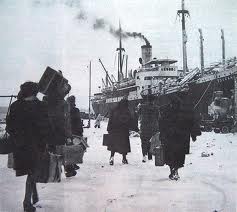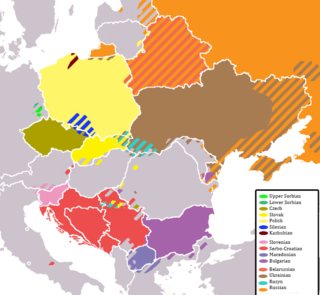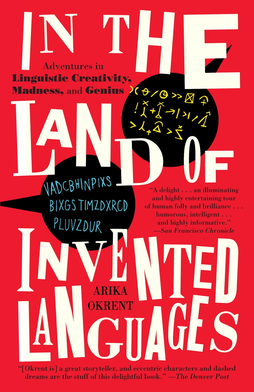Fictional languages are the subset of constructed languages (conlangs) that have been created as part of a fictional setting. Typically they are the creation of one individual, while natural languages evolve out of a particular culture or people group, and other conlangs may have group involvement. Fictional languages are also distinct from natural languages in that they have no native speakers. By contrast, the constructed language of Esperanto now has native speakers.

Ukrainian is an East Slavic language of the Indo-European language family spoken primarily in Ukraine. It is the native language of a majority of Ukrainians.

Dalmatia is one of the four historical regions of Croatia, alongside Central Croatia, Slavonia, and Istria, located on the east shore of the Adriatic Sea in Croatia.

Dalmatian or Dalmatic was a group of Romance varieties that developed along the coast of Dalmatia. Over the centuries they were increasingly influenced, and then supplanted, by Croatian and Venetian.
The Istriot language is a Romance language of the Italo-Dalmatian branch spoken by about 400 people in the southwestern part of the Istrian peninsula in Croatia, particularly in Rovinj and Vodnjan. It should not be confused with the Istrian dialect of the Venetian language or the more distantly related Istro-Romanian, a variety of Eastern Romance.
Venedic is a naturalistic constructed language, created by the Dutch translator Jan van Steenbergen. It is used in the fictional Republic of the Two Crowns, based on the Polish–Lithuanian Commonwealth, in the alternate timeline of Ill Bethisad. Officially, Venedic is a descendant of Vulgar Latin with a strong Slavic admixture, based on the premise that the Roman Empire incorporated the ancestors of the Poles in their territory. Less officially, it tries to show what Polish would have looked like if it had been a Romance instead of a Slavic language. On the Internet, it is well-recognized as an example of the altlang genre, much like Brithenig and Breathanach.
A constructed writing system or a neography is a writing system specifically created by an individual or group, rather than having evolved as part of a language or culture like a natural script. Some are designed for use with constructed languages, although several of them are used in linguistic experimentation or for other more practical ends in existing languages. Prominent examples of constructed scripts include Korean Hangul and Tengwar.
Brithenig, or also known as Comroig, is an invented language, or constructed language ("conlang"). It was created as a hobby in 1996 by Andrew Smith from New Zealand, who also invented the alternate history of Ill Bethisad to "explain" it. Officially according to the Ill Bethisad Wiki, Brithenig is classified as a Britanno-Romance language, along with other Romance languages that displaced Celtic.
An artistic language, or artlang, is a constructed language designed for aesthetic and phonetic pleasure. Constructed languages can be artistic to the extent that artists use it as a source of creativity in art, poetry, calligraphy or as a metaphor to address themes such as cultural diversity and the vulnerability of the individual in a globalizing world. They can also be used to test linguistical theories, such as Linguistic relativity.

In linguistics, mutual intelligibility is a relationship between different but related language varieties in which speakers of the different varieties can readily understand each other without prior familiarity or special effort. Mutual intelligibility is sometimes used to distinguish languages from dialects, although sociolinguistic factors are often also used.

The Eastern Romance languages are a group of Romance languages. The group, also called the Balkan Romance or Daco-Romance languages, comprises the Romanian language (Daco-Romanian), the Aromanian language and two other related minor languages, Megleno-Romanian and Istro-Romanian.

The Italian language is an official minority language in Croatia, with many schools and public announcements published in both languages. Croatia's proximity and cultural connections to Italy have led to a relatively large presence of Italians in Croatia.

A constructed language is a language whose phonology, grammar, orthography, and vocabulary, instead of having developed naturally, are consciously devised for some purpose, which may include being devised for a work of fiction. A constructed language may also be referred to as an artificial, planned or invented language, or a fictional language. Planned languages are languages that have been purposefully designed; they are the result of deliberate, controlling intervention and are thus of a form of language planning.

A pan-Slavic language is a zonal auxiliary language for communication among the Slavic peoples.

Italians of Croatia are an autochthonous historical national minority recognized by the Constitution of Croatia. As such, they elect a special representative to the Croatian Parliament. There is the Italian Union of Croatia and Slovenia, which is a Croatian-Slovenian joint organization with its main site in Rijeka, Croatia and its secondary site in Koper, Slovenia.

Dalmatian city-states were the Dalmatian localities where the local Romance population survived the Barbarian invasions after the fall of the Western Roman Empire in the 400s CE. Eight little cities were created by indigenous inhabitants who maintained political links with the Eastern Roman Empire which defended these cities, enabling their commercial trade.

In the Land of Invented Languages: Esperanto Rock Stars, Klingon Poets, Loglan Lovers, and the Mad Dreamers who Tried to Build a Perfect Language is a 2009 non-fiction book by linguist Arika Okrent about the history and culture of constructed languages, or conlangs, languages created by individuals. Okrent explores the motivations for creating a language, the challenges faced by such projects, and the outcomes of a number of high-profile conlangs. The book revolves around six conlangs: John Wilkins' unnamed 'philosophical language', Esperanto, Blissymbols, Loglan and its descendant Lojban, and the Klingon language designed for the Star Trek universe. Okrent describes her personal experiences learning and interacting with these languages and their speakers, and provides historical and linguistic analyses of their structures and features.











